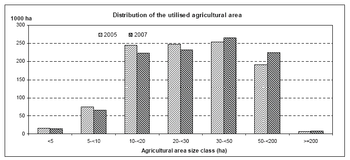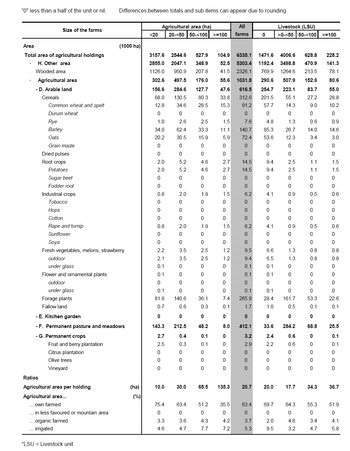Archive:Farm structure in Norway - 2007 results
- Data from October 2008, most recent data: Further Eurostat information, Main tables and Database.
This article is part of a series of country-specific essays on the results of the European Union (EU) Farm structure survey (FSS) 2007. It provides a brief but nevertheless comprehensive insight into farm structure in Norway.
The 2007 FSS recorded 49 900 agricultural holdings in Norway, which represents a 6 % decrease since 2005.
Main statistical findings
The area used for organic farming increased by 9 %
In 2007, about 49 800 agricultural holdings in Norway had an economic size of at least one European size unit (ESU), compared to 52 800 in 2005 (a 5.6 % reduction).
These farms made use of 1.03 million hectares (ha) of utilised agricultural area, (the same as in 2005), which makes the average size of a holding in Norway 20.7 ha (compared with 19.6 ha in 2005). See Graph 1 for the distribution of UAA in terms of farm size, while Table 2 describes the size distribution and other characteristics of the agricultural holdings.
These holdings employed 56 200 annual work units (AWUs), the equivalent of 56 200 people working full time, a decrease of 4.5 % since 2005. The organization and distribution of the labour force in Norway is described in Graph 2 and Table 1).
The farms contained 1.27 million livestock units (LSU) in 2007, 1 % more than in 2005. The distribution of livestock by farm size is shown in Table 4 and Graph 3.
Amongst the 49 800 agricultural holdings in 2007:
- 48.2 % made use of less than one AWU, while another 13.4 % made use of two or more AWUs;
- 60 % used less than 20 ha, while 6 % used 50 ha or more;
- 25 % of Norwegian farms specialised in dairy farming;
- 24 % were engaged in sheep, goats and other grazing livestock;
- 17 % specialised in cereals, oil seed and protein crops;
- 8 % were specialists in cattle – rearing and fattening;
- 7 % were specialists in general field cropping;
Amongst the sole holders:
- 13 % were women in 2007;
- 36 % were aged 55 or more and 8 % were younger than 35 years (1 % less than in 2005); and
- 79 % had another gainful activity in 2007.
In Norway in 2007, 63 % of the agricultural area was farmed by its owners.
The family labour force represents 80 % of the total labour force - a 8 % decrease from 2005 to 2007.
There was a 3% increase in the number of holdings under organic production . The area under organic farming grew by 9 % in the same time; in 2007 it counted for 4 % of the UAA.
The area used for cereals decreased by 4%. Between 2005 and 2007 the area used for barley decreased by 14%.
The situation for subsistence farming in Norway is outlined in Table 5.
Data sources and availability
Due to the different coverage of the FSS across Member States, the total number of farms is not comparable between countries. This is why the present analysis, including Tables 1-4 and the graphs focus on holdings of at least one European size unit (ESU).
The Norwegian survey on the structure of agricultural holdings was carried out by Statistics Norway based on two main sources: the population of agricultural holdings taken from the System of Application for Government Production Subsidies (PRO), with 31 of July as the registration date, and the annual Sample Survey of Agriculture (providing information on labour input, irrigation and rural development with 1st of June as the reference date and the prior 12 months for the labour characteristics).
The target population of the FSS 2007 was the same as for the Census in 1999, and the sample surveys in 2001, 2002, 2003, 2005 and 2006 and includes all holdings with at least 0.5 ha of UAA, or keeping livestock or cultivating horticultural crops over a certain threshold. The total population was close to 50 000 holdings, 3.6 % not applying for subsidies.
The sample used in FSS 2005 was updated (removing the ceased holdings and adding the new ones) and was used for the 2007 FSS. The sample design was based on three stratification criteria: 18 counties, 6 classes of UAA and 8 farm types. The sample size was close to 11 000 holdings.
The questionnaires were mailed to the respondents. It was their responsibility to fill them out and to mail them back to Statistics Norway. Another option (that has been available since 2005) was to fill out the electronic version of the questionnaire. In the case of FSS 2007 28% of the respondents chose this method (compared to 22% in 2005). The non-response rate was 10%. Reweighing was used for unit non-response. Item non-response was corrected with data from additional sources.
The administrative data used in the FSS (about 80 crop and livestock characteristics) were taken from the System of Application for Government Production Subsidies (PRO).
For each activity (`enterprise`) on a farm (for instance wheat or dairy cow), a standard gross margin is estimated, based on the area (or the number of heads) and a regional coefficient. The sum of such margins in a farm is its economic size, expressed in European size units (ESU, 1 ESU is a 1200-euro SGM).
An annual work unit (AWU) is equivalent to a worker employed on a full time basis for one year. In Norway it is 1845 hours (230.6 working days of 8 working hours per day).
A livestock unit (LSU) is equivalent to a dairy cow. The number of animals (number of heads) is converted into LSU using a set of coefficients reflecting the feed requirements of the different animal categories.
Context
European Commission Rural development policy aims to improve competitiveness in agriculture and forestry, improve the environment and countryside, improve the quality of life in rural areas and encourage the diversification of rural economies.
As agriculture has modernized and the importance of industry and services within the economy has increased, so agriculture has become much less important as a source of jobs. Consequently, increasing emphasis is placed on the role farmers can play in rural development, including forestry, biodiversity, the diversification of the rural economy to create alternative jobs and environmental protection in rural areas.
The FSS continues to adapt to provide timely and relevant data to help analyze and follow these developments.
Further Eurostat information
Publications
- Farm Structure Survey in Norway - 2007 - Statistics in focus 100/2009
- National Methodological Report – FSS 2007 Norway (available on request)
Main tables
- Agriculture, see:
- Structure of agricultural holdings (t_ef)
Database
- Agriculture, see:
- Structure of agricultural holdings (ef)
Dedicated section
- Agriculture, see:
- Ad-hoc tables: Farm Structure Survey
Methodology / Metadata
- Structure of agricultural holdings (ESMS metadata file - ef_esms)







